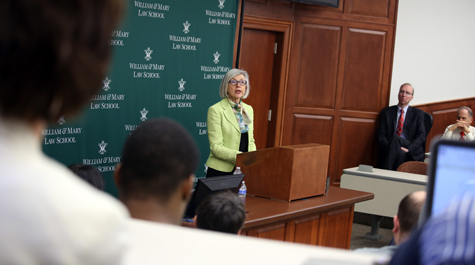Chief justice of Canada reflects on 35 years as a judge
William & Mary Law School recently hosted Chief Justice of the Supreme Court of Canada Beverley McLachlin for the annual Williamson Fellow lecture.
Her talk, “35 Years a Judge: Reflections on the Canadian Constitution,” explored the development of Canadian constitutional law against the background of a diverse nation of British, French and aboriginal language and law. The April 14 event was attended by students and faculty.
Dean Davison M. Douglas welcomed the chief justice to William & Mary, saying that her visit continued the tradition of William & Mary’s interest in international law. As the first law school to establish an international summer study program, William & Mary currently hosts visiting scholars, international students and global leaders in law, including South African Constitutional Court Justice Albie Sachs in 2014.
McLachlin, the first woman to hold the position of chief justice in Canadian history, was appointed to the Supreme Court of Canada in 2000. Linda Malone, Marshall-Wythe Foundation Professor of Law at William & Mary, first met the chief justice when they worked together on the board of the International Society for the Reform of Criminal Law.
Malone described the chief justice’s “meteoric rise through the Canadian courts” and her particular legacy relating to the development of aboriginal rights. Noting that McLachlin is “universally admired, respected, and just very well liked,” Malone described how she led the judiciary through volatile and innovative moments in Canadian jurisprudence and through contentious developments in the right-to-die and the Quebec succession movement.
During her lecture, McLachlin discussed revolution versus evolution in the comparative constitutional voyage in Canadian and U.S. history. Unlike the United States’ revolutionary foundation, Canada’s 1982 constitution was a product of incremental change. She underscored that while each country’s unique history necessarily produces different constitutions with different idiosyncrasies, the two nations can still learn much from each other.
“You have to tread the path of experience,” McLachlin remarked, quoting W&M Law School’s namesake, George Wythe. She depicted Canada’s history as one of “respectful accommodation.” Unlike the "melting pot" of the U.S., McLachlin likened Canada to a mosaic, where “these pieces unite to make a unified picture — one hopes — but a picture in which the identity of all the constituent parts can still be seen if one looks closely ... Canada not only permits but fosters the continuance of distinct cultural differences.”
This is reflected, she noted, in jurisprudence developed to favor inclusion over exclusion, to accommodate diversity over rejection of the other.
McLachlin likened the Canadian Constitution to a living tree.
“The tree of the constitution stands firm and fixed, rooted in law, but is capable of sprouting a new leaf, growing a new twig,” she said.
An example of Canada’s incremental evolution was notably determined by Edwards v. A.G. of Canada, known as the “persons” case. A group of five women challenged a Canadian law that denied women the right to hold public office. Under the traditional reading, the term “persons” was limited to male citizens. The law was eventually struck down after a series of appeals; despite prior precedent, the “living tree” interpretation of the constitution allowed the recognition and expansion of women’s rights.
The chief justice challenged the audience to consider how to draw limits on fundamental rights. Unlike the U.S. Constitution, which declares rights as absolute, the Canadian 1982 charter expressly allows limiting rights if the law limiting the right has an important goal, she said. The judiciary must question if the ends are legitimate and compelling, and if the means are rationally and narrowly tailored. The judiciary places great deference on legislative decisions; and in the event a law is questionable, the Supreme Court and the legislature can engage in a dialogue, where the law is returned to the legislature to address any constitutional issues prior to a final ruling by the Supreme Court of Canada.
The audience asked questions ranging from the use of cameras in the Supreme Court of Canada, which televises most arguments and rulings, to balancing the scope of rights with the needs of the state.
McLachlin was admitted to the Alberta Bar in 1969 and to the British Columbia Bar in 1971, practicing law in both Alberta and British Columbia. Prior to serving as a judge, she taught for seven years in the faculty of law at the University of British Columbia as a tenured associate professor. Her judicial career began in April 1981 when she was appointed to the Vancouver County Court. In September 1981, she was appointed to the Supreme Court of British Columbia. She was elevated to the British Columbia Court of Appeal in December 1985 and was appointed chief justice of the Supreme Court of British Columbia in September 1988. Seven months later, in April 1989, she was sworn in as a justice of the Supreme Court of Canada.
On Jan. 7, 2000, she was appointed chief justice of Canada. In addition to her judicial duties at the Supreme Court, the chief justice chairs the Canadian Judicial Council, the Advisory Council of the Order of Canada and the Board of Governors of the National Judicial Institute. She is also the author of numerous articles and publications.
The Williamson Fellowship was established in honor of William & Mary Law Professor Richard A. Williamson, in recognition of 37 years of service at the law school as professor, college counsel and coordinator of legal affairs. The Williamson Fellow brings in distinguished lawyers and judges of extraordinary caliber to share their experiences with the W&M Law School community.
















